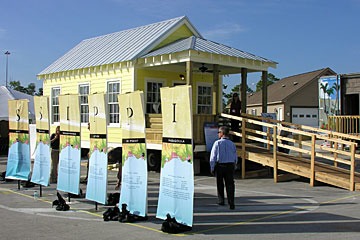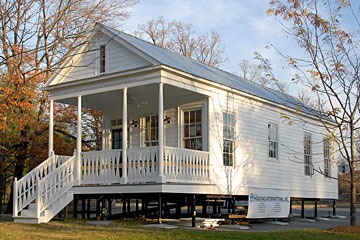search the Original Green Blog

Smaller buildings often tap into an unexpected source of lovability that just might be a basic survival mechanism for humans and other creatures as well. I call it the Teddy Bear Principle. Here's how it works: Baby bears are considered to be so cute that we give every American child a teddy bear before they're two weeks old. But the mother bear is so terrifying that nobody wants to get within two miles of her. How can this be?

me at three - obviously not
a mini-me of me today -
and like most of us, cuter
as a kid than as an adult
It's all about proportion. Claws and fangs get longer in proportion to the size of the bear's body as they mature, as you can see. The bear's body more than doubles in size, while its head doesn't get so much bigger. A cub's eyes appear larger on its face because while its head won't grow so much, its eyes are even closer to their adult size.
Humans and other creatures are similar. A young child can barely reach to the top of its head, while most adults can reach all the way over the top of their head to their ear on the other side. That's because our arms grow more than our head does from infancy to adulthood.

Andrés Duany helping set up the Katrina Cottage
exhibit at the IBS
Public response to the first Katrina Cottages was so strong that it shocked me. I was one of a dozen or so New Urbanists who manned the Katrina Cottage at the International Builders Show in January 2006. People were falling all over themselves to express how much they loved the little cottage. Later prototypes got the same response. For over a year, I was at a loss to explain why so many people acted the way they did about this little cottage.

Katrina Cottage VIII on temporary display near
Washington DC
I finally realized that it was the Teddy Bear Principle at work. When you make a house substantially smaller, not everything shrinks equally. The windows, for example, can only get so small before they fail to meet building codes. Windows are the eyes of a building, and so windows proportioned larger to the face of the building take on the same infant proportions as cubs, babies, fawns, puppies, and kittens.

These small creatures are often characterized with terms that make architects cringe: "adorable," "precious," "cute," "darling," etc. But it's precisely this outpouring of gut emotion that I believe plays a role in keeping our respective species alive. If the little ones weren't so lovable, then what might we do with them when they're screaming their heads off at three in the morning? Because they are so lovable most of the time, we suffer the sleepless nights for them, and life goes on. As it does for the other creatures as well.
This is important because when we build smaller and smarter, all sorts of virtuous cycles kick in to help us build more frugally. Cross ventilation and daylighting, for example, come naturally in tiny buildings that are only one room deep, whereas they require increasing doses of cleverness as the building gets larger. Compound frugal patterns like these with the fact that you're conditioning a lot less space, and you're saving even more.
The great thing about the Teddy Bear Principle is that if you know about it, you don't have to sell the idea of building smaller and smarter on cost savings alone. If you follow Teddy Bear Principle rules of proportion, then your designs will be much more lovable as well.
~Steve Mouzon
Legacy Comments
Steve Mouzon · Board Member at Sky Institute for the Future
I discovered the Teddy Bear Principle while trying to figure out why people love Katrina Cottages so much. But the Teddy Bear Principle doesn't just explain how to design smaller cottages better... I think it's actually a much deeper phenomenon that keeps life going by creating strong bonds between the adults and the little ones.
marcszar
Intriguing points, but there also are non-teddy bear spaces/places that people seem to love too. (If someone wanted to demo Grand Central today, people would throw a fit!)
It seems that large spaces, if properly proportioned and detailed, can also be comforting in a different way: I've never heard anyone call GCT "cute" or "adorable," but I've heard "spiritually uplifting" and "ennobling" and "empowering."
But yeah, I'd definitely agree that intimate spaces/places (and objects) stir something in us - "Oh, look at that weeny.."
I guess the mystery is why so many people fell for the cavernous, poorly-proportioned McMansions with their drafty, banal "great halls" and other oversized, alienating spaces?
Doris Sussman Goldstein · Works at Doris S. Goldstein, Planning Consultant
In my hodgepodge neighborhood--which ranges from riverfront mansions to small cinder block homes--someone fixed up an old cottage that sat at the front of their property, in front of their much larger home on the river. As I walked by with friends, they invariably commented on how appealing the cottage was and how they would enjoy living in the renovated cottage--even though it was a quarter of the size of the homes they actually lived in.
I believe it appealed to them because it promised a simpler lifestyle: that if they lived in this smaller, cozier space, their lives would be stripped of much of its complexity, and they would be happier as a result. Perhaps it also reminded them of their younger days, before they had all the possessions that accompany middle-aged life.
I do think that you are right about the proportions of the Katrina Cottage, particularly how the (relatively) over-sized windows and porch add to their appeal. But I also think that the purity of its form allows people to project onto the cottage a wish for calm and tranquility accompanying the simpler life they imagine they would have there.
Liesl Schick · Processing at Cromaine District Library
We stayed in a cabin recently that was 13 x 29 feet. The bedroom had a queen size bunk bed in the middle and a twin size bunk along one wall so that all six of us slept in one room. Our kids ages are 15, 12, 10, and 7. The kids most memorable experience and what they are still talking about 2 months later? Sleeping all together in the same room. They loved it and still say that was their favorite part and why can't we do that all time?
1,968+


